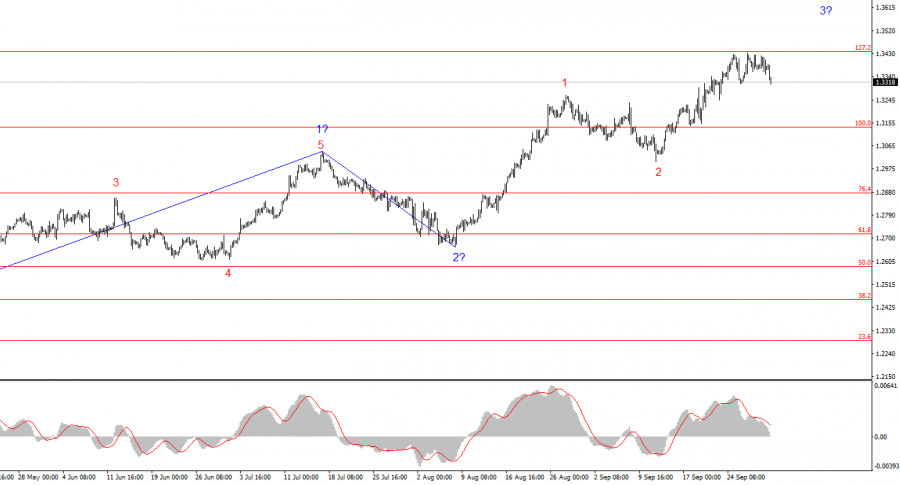Vea también


 01.10.2024 04:19 PM
01.10.2024 04:19 PMThe wave pattern for GBP/USD remains quite complex and continues to take on an increasingly extended form. At one point, the wave structure looked quite convincing and suggested a downward set of waves targeting levels below the 1.2300 level. However, in practice, demand for the British pound continues to grow, disrupting any wave formations. The market continues relentlessly to increase long positions.
At this time, I can only assume a significant complication of the upward trend, which began on April 22. If this assumption is correct, then waves 1 and 2 in (c) have already formed. If so, the construction of the upward wave 3 in (c) began on August 8, which also takes on an extended, five-wave structure. Consequently, the pound has the potential to rise up to the 1.4000 level, which would only be the third wave in the projected (c). A fifth wave may follow, which could also take on a five-wave structure.
The GBP/USD rate fell by 10 basis points on Monday, and lost another 45 today. I can't say that the pound is falling quickly or strongly; the euro, for example, is declining at a much faster rate. In the near future, we might witness a rare situation in the currency market where the euro and pound move in opposite directions against the US dollar. Most likely, the pound will also decline, but at a much slower pace than the euro. Even this week, the UK GDP report was weak. Jerome Powell indicated that a 50-basis-point rate cut in November is unlikely, yet demand for the U.S. dollar is growing slowly and reluctantly. Undoubtedly, the market had two additional factors to reduce demand for the euro—inflation in Germany and the EU. In the UK, inflation remains above the target level and could accelerate in the second half of the year, as repeatedly mentioned by Andrew Bailey and other BoE officials. Consequently, if the pound sterling declines, it will likely do so at a slower pace due to higher inflation in Britain.
If inflation rises or doesn't fall toward the target, the central bank will likely maintain the current interest rate longer or reduce it at a slower pace. This factor may sustain demand for the pound in the market. Additionally, the current wave pattern suggests further upward movement, not a decline. Of course, this pattern could change, as it often does in 2024. However, at this point, the upward trend doesn't seem to be over.
The wave pattern for GBP/USD continues to become more complicated. If the upward trend began on April 22, it will take quite a long time to develop. I still find selling opportunities to be more attractive, but clear signals are needed. Currently, I have no doubt that the formation of a new upward wave has begun and is ongoing. The nearest target for this wave is the 1.3440 level, which corresponds to the 127.2% Fibonacci level. A successful breakthrough at this level could lead the market toward the 1.3800 level.
On a higher wave scale, the wave structure has transformed. We can now assume the formation of a complex and extended upward corrective structure. At the moment, it's a three-wave pattern, but it could transform into a five-wave structure, which might take several more months or even longer to complete.
You have already liked this post today
*El análisis de mercado publicado aquí tiene la finalidad de incrementar su conocimiento, más no darle instrucciones para realizar una operación.
Lo más probable es que se esté formando una tendencia alcista mayor en el panorama global del SP500, cuya estructura es similar a la del impulso. Si nos fijamos
La estructura de ondas del instrumento GBP/USD sigue siendo bastante complicada y muy confusa. Alrededor del nivel de 1.2822, que corresponde al 23.6% de Fibonacci y está cerca del pico
El patrón de onda para el instrumento GBP/USD sigue siendo bastante complicado y confuso. Un intento exitoso de romper el nivel de Fibonacci del 50,0% en abril indicó
El patrón de onda para el instrumento GBP/USD sigue siendo bastante complicado. El intento exitoso de romper el nivel de Fibonacci del 50,0% en abril indicó que el mercado está
El patrón de onda del gráfico de 4 horas para el instrumento EUR/USD se mantiene sin cambios. En este momento, estamos observando la construcción de la onda esperada
El análisis de ondas del gráfico de 4 horas para el par euro/dólar sigue siendo bastante claro. Durante el año pasado, solo hemos visto tres estructuras onduladas que se alternan
Notificaciones
por correo electrónico y mensaje de texto

Your IP address shows that you are currently located in the USA. If you are a resident of the United States, you are prohibited from using the services of InstaFintech Group including online trading, online transfers, deposit/withdrawal of funds, etc.
If you think you are seeing this message by mistake and your location is not the US, kindly proceed to the website. Otherwise, you must leave the website in order to comply with government restrictions.
Why does your IP address show your location as the USA?
Please confirm whether you are a US resident or not by clicking the relevant button below. If you choose the wrong option, being a US resident, you will not be able to open an account with InstaTrade anyway.
We are sorry for any inconvenience caused by this message.


